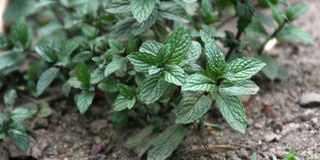Simple way to keep pests away using mint

A mint plant that is used in pest control at the Oserian flower farm in Naivasha, Nakuru County. PHOTO | SULEIMAN MBATIAH | NATION MEDIA GROUP
What you need to know:
- The wonder crop, adds Musyoka, can be used as a mosquito repellant. “By planting it within your compound, the plant repels mosquitoes reducing the risks of contacting malaria.”
- “Our researchers found out that mint attracts whiteflies, not only from our flowers but other crops as well. We are now producing and using it in our greenhouses,” says Stephen Musyoka, the Research and Development Manager at Oserian Farm in Naivasha.
Mint is popularly known for its great flavour, the reason why it is used in making candies and soft drinks.
Many farmers, however, do not know the other side of mint that is yet to be explored, which can save them plenty of money that they spend on pesticides.
Mint works as a natural pest control, and can be used well in greenhouses.
“Our researchers found out that mint attracts whiteflies, not only from our flowers but other crops as well. We are now producing and using it in our greenhouses,” says Stephen Musyoka, the Research and Development Manager at Oserian Farm in Naivasha.
At the farm, they usually use it in greenhouses to curb whiteflies, which are a threat to flowers.
“We normally place mint in flower bushes where there are whiteflies. The strong sweet scent of mint attracts the flies, pulling them away from flowers,” explains Musyoka. “We call it the pull and push method.”
They then spray the mint with pesticides killing the whiteflies. This ensures minimal use of chemicals on the flowers.
The method, according to Musyoka, can be used on other crops and work effectively as it does with flowers.
“Crops like broad beans (noe), tomatoes and different varieties of vegetables are prone to whiteflies. Placing mint close to them and then spraying the mint can work well than spraying the whole farm.”
MOSQUITO REPELLANT
The wonder crop, adds Musyoka, can be used as a mosquito repellant. “By planting it within your compound, the plant repels mosquitoes reducing the risks of contacting malaria.”
And that is not all, mint can also be used to keep pests that bite animals like cats and dogs at bay. “Crash the mint leaves and rub them on the animals’ skin. The plant will repel insects.”
Musyoka, however, advises that farmers must control the growth of mint on their farms as it can easily spread and take more than the intended space.
“Growing mint in cans or plastic bags is the best way to avoid spreading of this wonder plant.”
Prof Julius Ochuodho, a scientist at the University of Eldoret, says mint does not attract insects physically, but the strong chemicals it produces is loved by the pests.
“Mint is not a magnet, it is the chemicals within the plant that produce a scent which attract insects from several metres away.”
Other insects that mint can attract include spider mites and aphids, according to Prof Ochuodho.
He encourages farmers to take advantage of mint in insect control to curb direct use of chemicals.
“Farmers should use natural pest control methods. Those methods that have been confirmed effective should be adopted by others to discourage use of synthetic chemicals.”





